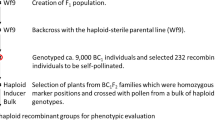Summary
Allotetraploidization is the creation of artificial allotetraploids. Allotetraploidization of maize can be accomplished by concentrating differential pairing affinity (DPA) factors into lines by a recurrent selection breeding system. Selection will be based on changes in genetic ratios which are the result of changes in the relative frequencies of various pairing configurations caused by DPA. Part 1 of this series gave extensive data on gene segregation in trisomic and tetraploid heterozygotes. Some of these tetraploids behaved like segmental allotetraploids. Part 2 presented a model for gene segregation in segmental allotetraploids. This paper presents an analogous model for gene segregation in trisomic heterozygotes. The pairing configurations of trisomes are analyzed by considering pairing in single arms which then are combined to obtain pairing configurations for whole chromosomes. The chromosome disjunction patterns of the various pairing configurations are hypothesized and expected genetic ratios are given that result from different levels of DPA expressed in several hypothetical trisomes. The model analyzes the effect of random pairing in one arm and non-random pairing in the other arms. Also, the effect of crossing over is taken into account. Because crossing over rates are affected by the environment, part of the variability in the data (Part 1) is explained. In addition, an hypothesis is advanced to explain the frequent enhancement of pairing affinity following x-irradiation.
Similar content being viewed by others
Literature
Alonso, L.C.; Kimber, G. (1981): Analysis of meiosis in hybrids. 2: Triploid hybrids. Canad. J. Genet. Cytol. 23, 221–234
Belling, J.; Blakeslee, A.F. (1923): The reduction division in haploid, diploid, triploid, and tetraploid Daturas. Proc. Nat. Acad. Sci. USA 9, 106–111
Burnham, C.R. (1950): Chromosome segregation in translocations involving chromosomes 6 in maize. Genetics 35, 446–481
Doyle, G.G. (1979a): The allotetraploidization of Maize, Part 1: The physical basis — differential pairing affinity. Theor. Appl. Genet. 54, 103–112
Doyle, G.G. (1979b): The allotetraploidization of maize, Part 2: The theoretical basis — the cytogenetics of segmental allotetraploids. Theor. Appl. Genet. 54, 161–168
Driscoll, C.J. (1979): Mathematical comparison of homologous and homoeologous chromosome configurations and the mode of action of gene regulating pairing in wheat. Genetics 91, 755–767
Driscoll, C.J.; Bielig, L.M.; Darvey, N.L. (1979): An analysis of frequencies of chromosome configurations in wheat and wheat hybrids. Genetics 91, 755–767
Driscoll, C.J.; Gordon, G.H.; Kimber, G.: Mathematics of chromosome pairing. Genetics 95, 159–169
Kimber, G.; Alonso, L.C.; Sallee, P.J. (1981): Analysis of meiosis in hybrids. I. Aneuploid hybrids. Can. J. Genet. Cytol. 23, 209–219
Kimber, G.; Alonso, L.C. (1981): The analysis of meiosis in hybrids. III. Tetraploid hybrids. Can. J. Genet. Cytol. 23, 235–254
Kimber, G.; Hulse, M.M. (1978): The analysis of chromosome pairing in hybrids and the evolution of wheat. In: Proc. 5th Int. Wheat Genet, (ed. Ramanjam, S.), pp. 63–72. New Delhi: Indien Society of Genetics and Plant Breeding
Mather, K. (1935): Reductional and equational separation of the chromosomes in bivalents and trivalents. J. Genet. 30, 53–78
Mather, K. (1936): Segregation and linkage in autotetraploids. J. Genet. 32, 287–314
Riley, R.; Chapman, V. (1958): Genetic control of the cytologicall diploid behavior of hexaploid wheat. Nature 182, 713–715
Sallee, P.J.; Kimber, G. (1978): An analysis of the pairing of wheat telocentric chromosomes. In: Proc. 5th Int. Wheat Genetics Symp. (ed. Ramanjam, S.), pp. 408–419. New Delhi: Indian Society of Genetics and Plant Breeding
Sears, E.R. (1958): The aneuploids of common wheat. In: Proc. 1st Int. Wheat Symp. (ed. Jenkins, B.C.), pp. 221–229. Winnipeg. Canada: Public Press Ltd.
Sved, J.A. (1966): Telomere attachment of chromosomes. Some genetical and cytological consequences. Genetics 53, 747–756
Author information
Authors and Affiliations
Additional information
Communicated by Å. Gustafsson
Contribution from Agricultural Research/Science and Education Administration, US Department of Agriculture, University of Missouri, Columbia, Missouri, Missouri Agric. Exp. Sta. Jounal Series No. 8 670
Rights and permissions
About this article
Cite this article
Doyle, G.G. The allotetraploidization of maize. Theoret. Appl. Genetics 61, 81–89 (1982). https://doi.org/10.1007/BF00261516
Received:
Issue Date:
DOI: https://doi.org/10.1007/BF00261516




